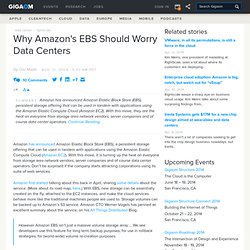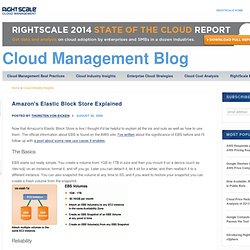

Cloudy_Scripts Home. Why Amazon's EBS Should Worry Data Centers: Tech News « Amazon has announced Amazon Elastic Block Store (EBS), a persistent storage offering that can be used in tandem with applications using the Amazon Elastic Compute Cloud (Amazon EC2).

With this move, it is turning up the heat on everyone from storage area network vendors, server companies and of course data center operators. Don’t be surprised if the company starts attracting corporations using its suite of web services. Amazon first started talking about this back in April, sharing some details about the service. (More about its road map, here.) With EBS, new storage can be essentially created on the fly, attached to the EC2 instances, and make the cloud services behave more like the traditional machines people are used to.
However Amazon EBS isn’t just a massive volume storage array … We see developers use this feature for long term backup purposes, for use in rollback strategies, for (world-wide) volume re-creation purposes. First, some facts about the service: Why this is a big deal? Amazon’s Elastic Block Store explained « RightScale Blog. Now that Amazon's Elastic Block Store is live I thought it'd be helpful to explain all the ins and outs as well as how to use them.

The official information about EBS is found on the AWS site. I've written about the significance of EBS before and I'll follow up with a post about some new use cases it enables. The Basics EBS starts out really simple. You create a volume from 1GB to 1TB in size and then you mount it on a device (such as /dev/sdj) on an instance, format it, and off you go. Reliability EBS volumes have redundancy built in, which means that they will not fail if an individual drive fails or some other single failure occurs.
I know that folks at Amazon have thought long and hard how to characterize the reliability of EBS volumes. Amazon EBS volumes are designed to be highly available and reliable. From a practical point of view what this means is that you should expect the same type of reliability you get from a fully redundant RAID storage system. Volume Performance Price. Getting Good IO from Amazon's EBS. The performance characteristics of Amazon’s Elastic Block Store are moody, technically opaque and, at times, downright confounding.

At Heroku, we’ve spent a lot of time managing EBS disks, and recently I had a very long night trying to figure out how to get the best performance out of the EBS disks, and little did I know I was testing them on a night when they were particularly ornery. On a good day, an EBS can give you 7,000 seeks per second and on a not so good day will give you only 200. On those good days you’ll be singing its praises and on the bad days you’ll be cursing its name.
What I think I stumbled on that day was a list of techniques that seem to even out the bumps and get decent performance out of EBS disks even when they are performing badly. Under perfect circumstances a totally untweaked EBS drive running an ext3 filesystem will get you about 80kb read or write throughput and 7,000 seeks per second. The tool I used to benchmark was bonnie++, specifically: